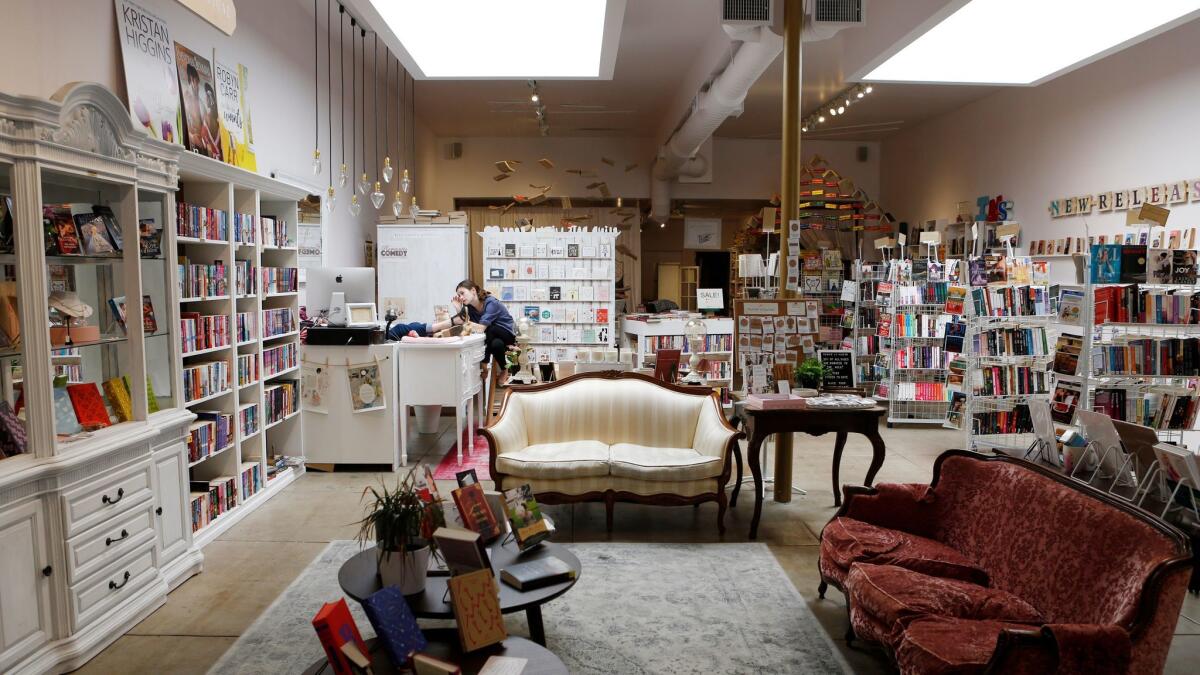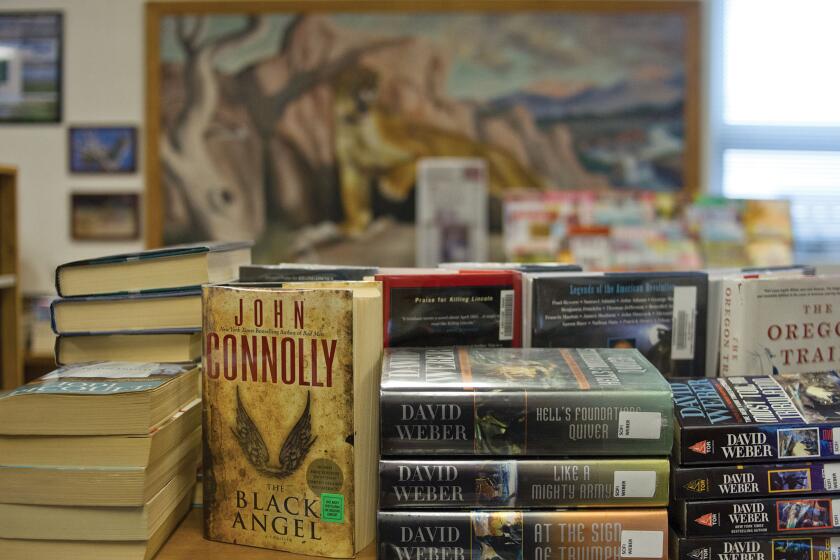Think the Regency was all corsets and patriarchy? A romance-lit fiend says think again
- Share via
On the Shelf
Mad & Bad: Real Heroines of the Regency
By Bea Koch
Grand Central: 272 pages, $18
If you buy books linked on our site, The Times may earn a commission from Bookshop.org, whose fees support independent bookstores.
In late spring, a hundred-pound sack of King Arthur flour arrived on the doorstep of Bea Koch’s Twentynine Palms home. It was still early in the coronavirus lockdown. Koch was on leave from the Ripped Bodice, the romance-focused Culver City bookstore that she and her sister Leah run, and she’d picked up a common pandemic habit: stress-baking. The flour was a gift from her father; the two had been bonding over their failed attempts to perfect sourdough.
Some five months later, Koch and her dad have both given up on the fermentation lifestyle. Instead, the flour is being put to more entertaining (and less finicky) uses: Koch has been creating pastries to promote her debut book, a fierce and fizzy piece of pop history called “Mad & Bad: Real Heroines of the Regency.” On her Twitter, Koch has posted pictures of the book’s title carved into the crust of a loaf of homemade bread, written on a black-and-white cookie and spelled out in a bowl of alphabet soup.
“If I’m baking this much, I have to do something productive with it, which is kind of my general life philosophy,” Koch said during a recent phone call. “It’s not probably the healthiest — I hear that — but I really like turning anything I like into something useful.”
That ethos is not particularly surprising, coming from someone who turned a love of romance novels into a thriving business. In November 2015, the Ripped Bodice was a dream and a Kickstarter project, and by March of the following year, it was a brick-and-mortar business. The word casual does not seem to be in Koch’s vocabulary.

She and her sister have always seen the Ripped Bodice as more than a retail operation; it’s important to them that the store is a welcoming, inclusive space that celebrates topics historically maligned for being considered feminine — you know, stuff like sex, love and happily-ever-afters. They’ve also dedicated themselves to promoting increased diversity in the industry, publishing “The State of Racial Diversity in Romance Publishing Report” every year since they opened.
As a child, Asha Grant didn’t know where to find books about people who looked like her. Next year she’ll open that place, the Salt Eaters, in Inglewood.
It’s in that same spirit that “Mad & Bad” revises what we though we knew of women’s lives during England’s brief but iconic Regency period. The book has been percolating since Koch was in college: while studying Renaissance History at Yale, she took a course on romance novels. Koch says the historical romances on the syllabus opened up a different world than the one she’d encountered in traditional books.
Readers unfamiliar with the popular subgenre might imagine Regency romances being populated entirely by wealthy white women who dream only of marriage and babies, but the genre is more diverse and subversive than that. In her reading, Koch encountered heroines engaging in scientific and political inquiries and pursuing same-sex love affairs — behaviors we associate with modern feminist culture (and modern romance novels) rather than straitlaced 1800s England.
Koch decided to trace those stories back to the period itself. “I knew that history was expansive because of fiction,” Koch says. “I was reading these romance novels with heroines who were doing all these amazing things, and I was looking for who had inspired them.”
The more she read, the more Koch saw a Regency that looked little like the popular conception of the period, mostly informed by Jane Austen novels and their BBC adaptations. “If we’re being accurate, then people of color, Jewish people, people with disabilities, members of the LGBT community — those people are all walking around in 19th century England,” she says. To those who cry “historical fallacy!” when a free Black woman appears in a Regency romance, Koch responds, “The historical record is a choice. It’s many choices that have been made, and we can try and go back and make different choices.”
She sees the book as just one part of a collective effort to reimagine our world, as marginalized groups claim their place in history alongside white men. “We are having a reckoning right now,” Koch says. “It’s been a long time coming, and a lot of people have been doing a lot of work for a lot of years to get us where we are. I’m so glad to see some of that really coming to fruition.”
The #PublishingPaidMe campaign on Twitter revealed disparities. Where do we go from here?
Another way of making change is being transparent about her own financial circumstances. Koch’s sister gave her a year’s sabbatical from co-running the Ripped Bodice so she could focus on researching, writing and promoting the book, but since she’s still a co-owner, “I had multiple income streams,” she explains. She also tweeted out her book advance along with the #PublishingPaidMe hashtag on Twitter, a project created by Black authors asking writers to reveal their advance numbers in order to shine a light on racial disparities in book deals.
“I got paid $30,000 [for “Mad & Bad”], and I will tell anyone who wants to know that, because it’s important,” Koch says. “There are so few of these pop culture history books even being published, and they’re mostly by white women. There are a lot of reasons for that.”
Koch says that her status as a publishing professional was both a help and a hindrance when it came to publishing her own book. For instance, she knew how important an eye-catching cover can be, and had her heart set on a particular image depicting three prominent Regency-era women as Macbeth’s witches gathered around a cauldron. Her publisher agreed to make it happen, but at sales conferences, booksellers had uniformly negative reviews: the colors of the image were too dark, they said, to stand out on crowded shelves.
It wound up being for the best: the final cover is a painting made by one of the book’s subjects, Rolinda Sharples, whose mother was a painter and taught her daughter her craft.
Sharples died of breast cancer in her mid-forties, but “her mother made it her mission to continue Rolinda’s work,” Koch explains. “She made sure to donate all her paintings, and she helped found a museum where Rolinda’s art now is.”
Ultimately, the image expresses exactly what Koch wanted to capture about the Regency: that it was filled with people much more recognizable than we might imagine. “It’s so familiar,” she says. “It almost makes my heart ache to think of the love a mother and a daughter have for each other, and how proud they are of each other, and how we have a record of it. I just think that’s so cool.”
“We wanted a lot of light in the space,” says Bea Koch from one of the baroque Victorian couches that form a makeshift living room in the center of the Ripped Bodice, America’s sole romance-only bookstore, which she owns with her sister Leah.
Romanoff is a writer and the author of several novels for young adults.
More to Read
Sign up for our Book Club newsletter
Get the latest news, events and more from the Los Angeles Times Book Club, and help us get L.A. reading and talking.
You may occasionally receive promotional content from the Los Angeles Times.











